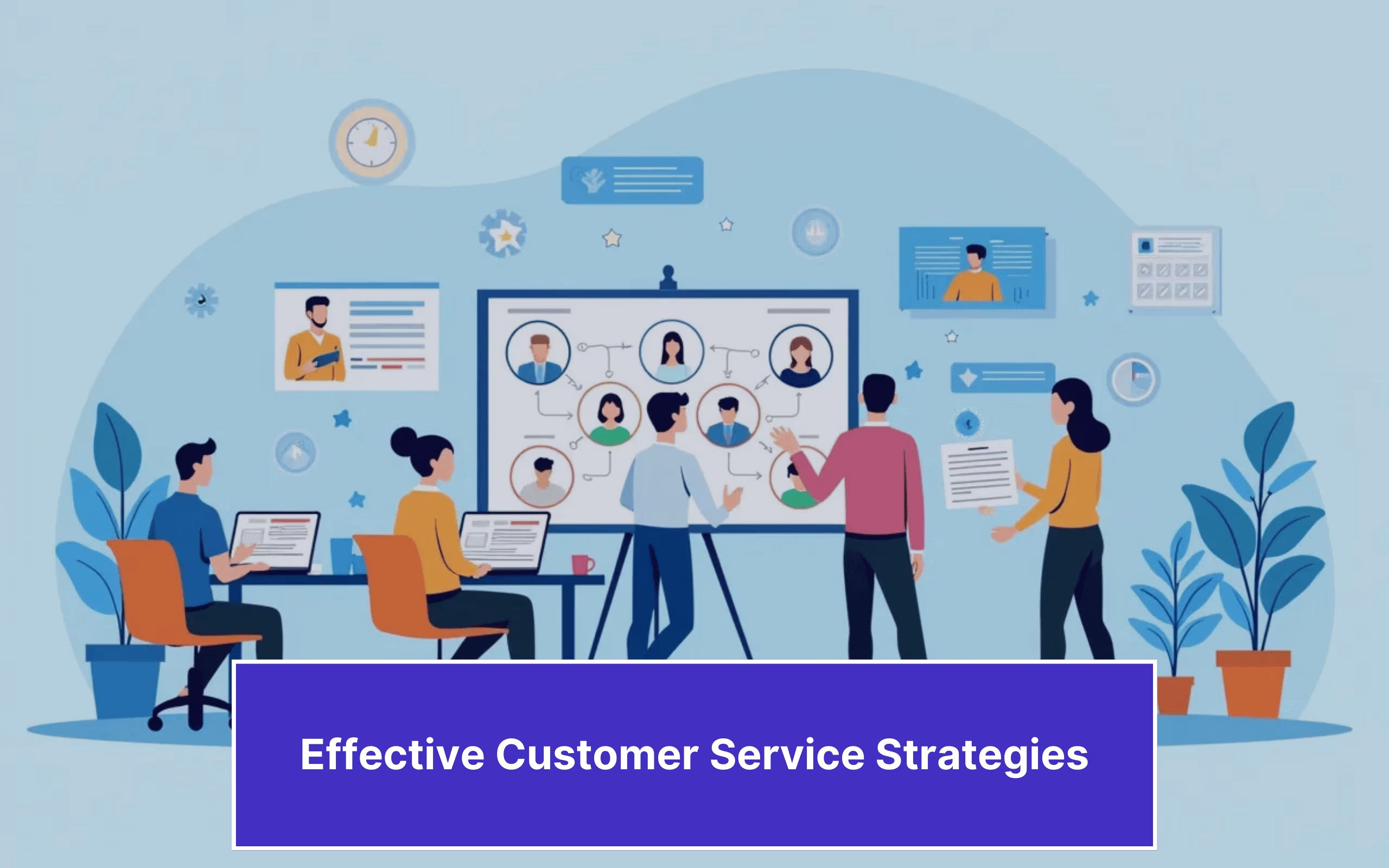Updated on March 17, 2025

“The best customer service is if the customer doesn’t need to call you, doesn’t need to talk to you. It just works.” This quote by Jeff Bezos emphasizes the need to develop intuitive and efficient customer service strategies that can proactively address customer requirements, reduce friction, and offer a seamless customer experience.
In an era where customers are spoilt for choices, businesses cannot afford to sideline customer service. In fact, they need to go above and beyond to provide top-notch customer service by responding to customer queries across their preferred platforms, offering apt solutions, and guiding them through the next steps.
The quality of your customer service can make or break your chances of gaining a competitive edge over your competitors. If you do not believe us, these numbers will. Around 65% of customers have switched brands due to a poor experience and more than 80% of consumers will explore a competitor after more than one poor experience.
This article delves into how businesses can develop a sound customer service strategy to deliver consistent and top-quality customer service.
Why is a Seamless Customer Service Strategy so Important?
The advent of customer service platforms has empowered customer-facing personnel to achieve more, deliver better experiences, and address customer queries more efficiently. These tools contribute toward the collective success of the business eventually boosting revenue.
Here are a few compelling reasons why every business must craft and implement an effective customer service strategy.
- Improve Customer Satisfaction and Retention
One of the most obvious benefits of flawless customer service is securing customer loyalty. It is also an effective way to nurture relationships and build trust by fulfilling their request and meeting their expectations. However, every business will need a focused customer service strategy to exceed expectations and encourage customers to make repeat purchases.
- Connects Different Customer-facing Teams
Customer service is a collective effort between different teams including customer success, service, and social customer care. A customer service strategy unites them and various complex processes to ensure everyone is on the same page and prevent duplicate efforts.
While customers enjoy shorter waiting times, support teams can eliminate the need to toggle between different platforms to deliver better agent experiences.
- Brand Credibility and Reputation
Businesses looking to expand and increase their market share have taken up customer service as a top priority to attract and retain customers. Personalization, instant replies to customer queries, structured processes, and proactive problem-solving have become an integral part of customer service strategies as they allow brands to build credibility and reputation, allowing them to stand the test of time.

Creating a Robust Customer Service Strategy
Now, let’s discover how you can create a solid customer service strategy for your business.
1. Understand and Identify Your Customers
You cannot serve your customers if you do not know who they are, what they need, and expect from your business. It always helps to understand the user journey and be available to assist them at every step of the way.
Put yourself in their shoes and identify areas of improvement. For instance, you can engage with your business’s support team as a customer and identify the areas of improvement along your journey. Ask yourself, what could’ve been better? Was the live chat pop-up a distraction? Was it easier to find the ‘Contact Us’ page? Are all the customer service channels highlighted clearly?
Adopt a customer-first philosophy and spend time researching the customer’s journey, recurring support inquiry themes, and pain points.
Find answers to the following questions:
- Are customers able to reach out to your support team across every stage of their journey?
- What are frequently asked questions at every stage?
- Are self-service support options available?
You can also identify the pulse of your customers and identify the areas of improvement by going through reviews or feedback. While positive feedback offers affirmation of factors that boost customer loyalty and satisfaction, negative feedback highlights areas where you need to improve.
2. Create a Rulebook
Although every business must focus on providing tailored customer support services, it is equally important to create a customer service rulebook and define guidelines your support staff must follow. Think of it as a reference point for existing members and training material for people who have just joined the team.
The rulebook must clearly define the best customer service practices and include the following:
- Business and team objectives
- Expectations from every team member
- Service and communication standards
- Expected tone and communication style
- Information about the available tools
- Clearly defined processes to handle different types of customer tickets across stages of their journey
- Escalation handling
3. Outline the KPIs
How do you evaluate whether your customer service strategy is working? You must define clear key performance indicators (KPIs) to measure success and determine whether you are on the right track.
Some of the most popular customer service KPIs include:
- First Response Time (FRT)
- Customer Satisfaction (CSAT)
- Customer Effort Score
- Net Promoter Score (NPS)
- Containment Rate
- Self-service score
- Churn and Retention Rate
- QA Evaluation Score
It is worth noting that it is only possible to gauge whether your customer service strategy is working if you can measure the key and relevant parameters. Remember; although many customer service analytics tools include countless KPIs, you need to identify only those relevant to your business.
4. Hire the Right Talent and Build a Customer Service Team
By now, you have enough data to assess strategies that are working, identify areas of improvement and define structured processes and KPIs. What about execution? You will need a team of experienced and capable customer care executives to execute your ideas and turn ideas into reality.
Many companies are tempted to save capital on customer support staff by hiring under-qualified and inexperienced individuals, which could damage the company’s credibility and reputation.
Build a team of motivated individuals who understand the nuances of customer service and carry a positive attitude. Customer service isn’t as straightforward as it seems and requires patience and the ability to deal with negative feedback.
5. Deploy the Right Technology Stack
Your customer service efforts will largely depend on the technology stack in place, so it is important to invest wisely. With hundreds of tools available in the market, picking the right tools that fit your budget can get a bit tricky.
It is imperative to pick a user-friendly help desk tool that facilitates seamless collaboration between the support staff. Deploy the right tools for the right services without overstepping your budget to ensure your customer service operations are cost-efficient. Consider using license management platforms to streamline software usage, eliminate unnecessary costs, and optimize license allocation across your team.
While live chat is a great addition to the list of customer service alternatives, AI-driven chatbots have gradually taken over. Design and integrate generative AI chatbots that provide accurate human-like responses to customer queries in the blink of an eye.
Invest in a customer-centric solution like Kommunicate’s AI chatbot that allows you to resolve customer queries seamlessly and enhance your First Contact Resolution rate (FCR)
6. Find the Right Communication Channels
Have you noticed how hotels and resorts have dedicated numbers for different types of assistance including housekeeping, room service, laundry, etc.? Similarly, you must identify the right channels for different types of customer queries and most importantly, be present where your customers are.
If your customers are on Facebook, your customer service team must engage them on Facebook. Similarly, if their preferred communication channel is WhatsApp, there isn’t any reason why you must ignore it and provide assistance on other messaging platforms.
The idea is to offer top-quality assistance through the customer’s preferred communication channels. And this also permeates other areas of customer service strategy including training and onboarding.
Make use of multi-module course creation tools to train your new customer service agents across various channels like text, video, and audio. Platforms like GetResponse with built-in course creation and knowledge sharing features can come in handy for this purpose.

7. Feedback Loops
Remember! Your customer service strategy will evolve with evolving consumer behaviors and tech advancements. You may need to tweak your processes and introduce new strategies periodically depending on different factors.
Therefore it is critical to have feedback loops in place. You can receive feedback from two main sources including internal team members and customers.
- Feedback from team members
Typically, customer-facing employees understand your customer service process and offer precious insights into customer and workflow-related challenges. Hear them out and get a better understanding of their experiences while dealing with customers, concerns, and other suggestions. If you run an online business, encourage the use of testing tools that can deliver this feedback directly from the stakeholders to the people running the show.
- Customer feedback
Just like your customer service strategy, your customer feedback is dynamic and not solely restricted to feedback forms and surveys. Chat transcripts, call logs, and recurring customer inquiries offer enough information to determine trends and spot areas of improvement.
The feedback loop will ensure you are proactively responding to negative feedback and improving your customer service efforts, leading to happier and more satisfied customers.
Transform your customer support with Kommunicate’s
AI-powered email ticketing—resolve queries faster than ever!Final Words
Offering flawless customer service isn’t enough in today’s business landscape. Businesses need to stretch boundaries and think of creative ways to offer effective and personalized customer service to set them apart from their competitors.
It is safe to assume that businesses with mediocre or dull customer service will not survive and be able to compete with those offering pleasant customer experiences. It is also essential to understand that having a customer service strategy on paper is only half the job done; the real work starts when you can implement and execute your ideas.
Use the advanced and AI-powered customer service solutions from Kommunicate to transform customer service, boost customer engagement, and offer personalized experiences.
As the Head of Growth, Marketing & Sales, Yogesh is a dynamic and results-driven leader with over 10+ years of experience in strategic marketing, sales, and business development.





